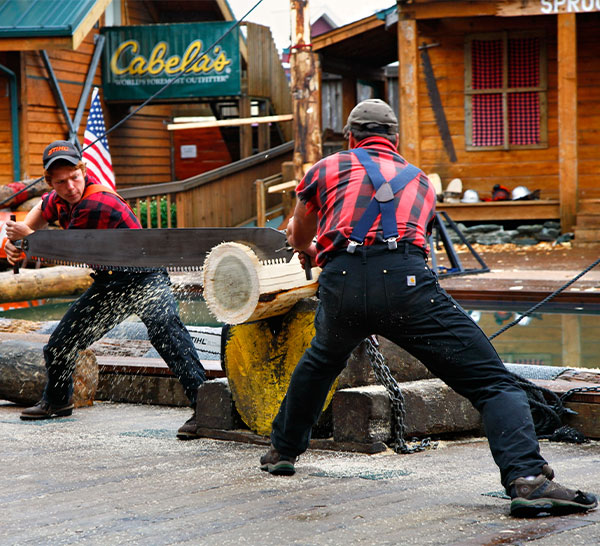Getaway to Alaska
by Susan Sommer
Photo credit: istock.com/Michael Xiao
Hear the staccato cry of a bald eagle calling for its mate through the mist; see towering spruce, hemlock, and cedar trees of the Tongass National Forest marching up the mountains; watch waves lapping the shore as you disembark the ship and head into Ketchikan, Alaska for a day of exploring. There are many sights and sounds of the “salmon capital of the world,” a title earned for its robust salmon runs. The fish figures prominently in the city’s Indigenous art.
With a population of approximately 8,000, Ketchikan sits at the southernmost entrance to Alaska’s Inside Passage and it hosts a plethora of adventure opportunities: fishing, kayak tours, tidewater glacier excursions, dining and hiking. Be sure to pack a raincoat though, as Ketchikan averages a whopping 150 inches of precipitation annually. Experience the history and natural beauty of the Great Land with a variety of ways to explore the Ketchikan area.
Cultural Attractions
photo credit: alamy.com/Pep Roig
The first stop for Alaska Native culture is the Totem Heritage Center, which houses totem poles carved in the 19th century. With guidance from Native elders, the Alaska State Museum and the Alaska Native Brotherhood relocated the totems from nearby abandoned villages to Ketchikan roughly 50 years ago. Though thoroughly weathered, the totems have retained their intricate detail—even some original paint—depicting people, events and legends, as well as clan history and origin. Traditionally, when a pole was raised during a potlatch celebration, its meaning was relayed orally, a way for youth to learn the vibrant stories of their heritage.
Decorated bentwood boxes that once held seaweed and salmon are also on display, as are hand-hewn masks and other ceremonial objects. Classes and workshops are offered in basketry and weaving, carving and engraving, and regalia creation. Cedar bark plaiting, anyone? Or perhaps moccasin sewing?
From the center, walk or ride a shuttle to the Tongass Historical Museum, with exhibits on Northwest Coast arts, aviation, logging, commercial fishing and more. A show called Cruisin’ the Fossil Coastline runs through January 2024 and features the whimsical creations of Ketchikan artist Ray Troll and paleontological finds from the North American coast by Dr. Kirk Johnson, director of the Smithsonian National Museum of Natural History. Together, the two logged more than 10,000 miles during this project in search of fossils and tales. Troll’s work, ubiquitous on T-shirts around Alaska, often uses colorful salmon imagery and sayings such as, “Spawn till you die” and “If you must smoke, smoke salmon.” Find Troll’s designs at his Soho Coho Gallery on Creek Street, Ketchikan’s infamous historical red-light district.
The Creek Street boardwalk is a must-see not only for its bawdy past—detailed on numerous plaques and interpretive panels—but also for the chance to see harbor seals and spawning salmon in the tidal waters that flow in and out below the boardwalks. Duck into cozy shops for souvenirs, gifts, local crafts and food.
Don’t miss the Great Alaskan Lumberjack Show, an energetic extravaganza of axe-wielding athletes demonstrating their skills at chopping, sawing, speed climbing, and log rolling, while the audience cheers for their favorites. Be sure to get a photo afterward with Lumberjack Rob “Silver Fox” (one of the show’s founders) or any of the other accomplished competitors.

Photo credit: alamy.com/Ron Niebrugge
Sights From the Natural World
photo credit: Hall Anderson
Tours from Ketchikan abound. Charter a boat to catch salmon, halibut, rockfish or cod. Hop on a day cruise or flightseeing float plane to nearby Misty Fjords and kayak for the afternoon. On the water, you’re likely to see humpback whales and bald eagles.
Stretch your legs on a hike, ranging from easy to difficult. Rainbird Trail is 1.3 miles one way, just a 500-foot elevation gain, and accessible from three locations. Meander through the rainforest and stop for panoramic views of the city and surrounding islands. Experienced hikers and backpackers can try the longer and steeper, 13.75 miles one way with 3,000 feet of elevation gain. See fs.usda.gov.
Hoping to see Alaska’s black bears? Try driving seven miles south on Tongass Highway to Herring Cove, site of an old cannery. Near low tide in summer, black bears frequent the water’s edge to munch on salmon. Locals and visitors gather to watch from a parking area overlooking the cove. Bring binoculars to see “up close” because it’s important to keep a safe distance from these wild animals.
A few miles north of downtown, Totem Bight State Historical Park makes a fine place for a beachside picnic. Wander among reconstructed Tlingit and Haida totem poles and peek inside a community clan house. Stop at the visitor information center for specifics about the park’s history and descriptions of each pole. For example, “Pole on the Point” is 68-feet tall; at the top is a shaman wearing a bear claw headdress and fringed apron. He holds a club, which symbolizes one of his spirit powers, and the figures below represent Tlingit legends. A village watchman stands guard at the top of “Sea Monster Pole” with two eagle crests, while the rest of the pole is carved with creatures from the sea.
Most travelers to Alaska can’t stop with just one trip, so after you visit Ketchikan, add the rest of the Great Land to your bucket list and start planning.
Getting There
photo credit: alamy.com/Sorin Colac
Ketchikan is accessible only by boat or plane. Cruise ships dock regularly throughout summer, and the Alaska Marine Highway System offers year-round passenger and vehicle transportation via ferry. Alaska Airlines and Delta Airlines fly to Ketchikan International Airport, located on Gravina Island. From there, a five-minute ferry ride deposits travelers across Tongass Narrows, where they can walk, catch a shuttle or take an Uber to downtown. 
Susan Sommer is a lifelong Alaskan and the editor of Alaska magazine.

